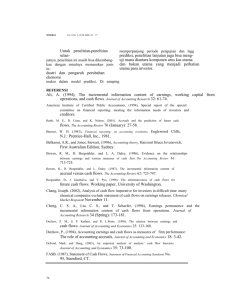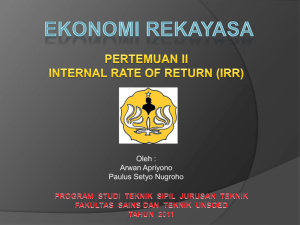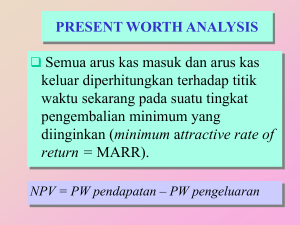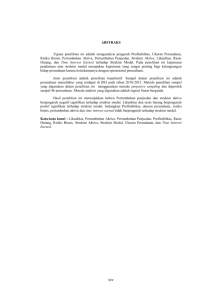Chapter 12 -- Capital Budgeting and Estimating Cash
advertisement
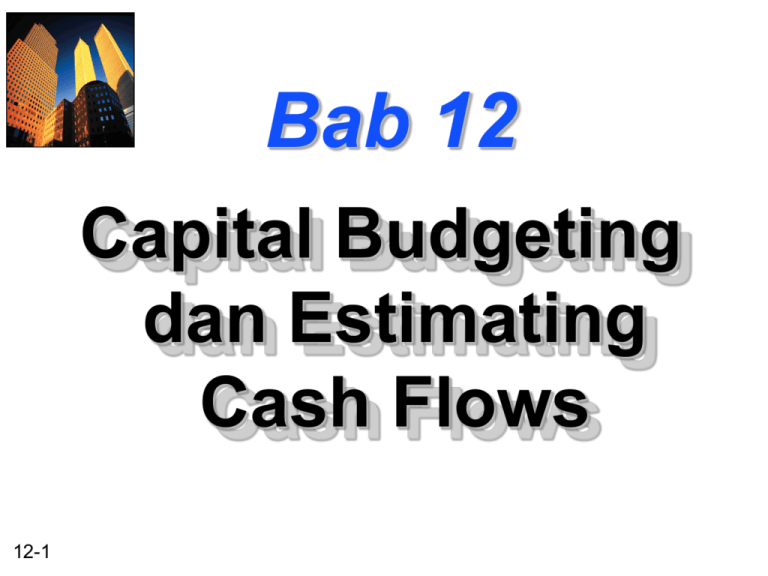
Bab 12 Capital Budgeting dan Estimating Cash Flows 12-1 Capital Budgeting dan Estimating Cash Flows 12-2 The Capital Budgeting Process Generating Investment Project Proposals Estimating Project “After-Tax Incremental Operating Cash Flows” What is Capital Budgeting? Proses mengindentifikasi, menganalisis, dan memilih proyek investasi yang diharapkan dapat memberikan return (arus kas) untuk periode lebih dari satu tahun . 12-3 Proses Capital Budgeting Penyusunan proposal investasi yang konsisten dengan sasaran strategis perusahaan Menyusun estimasi arus kas inkremental setelah pajak untuk proyek yang diusulkan Mengevaluasi arus kas inkremental yang dihasilkan oleh suatu proyek 12-4 The Capital Budgeting Process Memilih proyek berdasar kriteria penilaian (yaitu proyek yang memberikan nilai terbesar) Melakukan evaluasi ulang terhadap hasil implementasi proyek 12-5 KLasifikasi Proyek Investasi 1. Produk baru atau ekspansi produk 2. Proyek penggantian 3. Proyek riset dan pengembangan 4. Eksplorasi 5. Dll 12-6 Screening Proposals and Decision Making 1. Section Chiefs Advancement to the next 3. VP for Operations level depends on cost 4. Capital Expenditures and strategic Committee importance. 2. Plant Managers 5. President 6. Board of Directors 12-7 Estimating After-Tax Incremental Cash Flows Basic characteristics of relevant project flows 12-8 Cash (not accounting income) flows Operating (not financing) flows After-tax flows Incremental flows Estimating After-Tax Incremental Cash Flows Principles that must be adhered to in the estimation 12-9 Ignore sunk costs Include opportunity costs Include project-driven changes in working capital net of spontaneous changes in current liabilities Include effects of inflation Tax Considerations and Depreciation Depreciation: Proses pengalokasian secara sistematis sejumlah biaya yang terdapat pada suatu aktiva pada beberapa periode usia ekonomis Kegunaan: Pelaporan keuangan Pajak Metode Depresiasi: Garis Lurus MACRS 12-10 dll Depreciation and the MACRS Method Everything else equal, the greater the depreciation charges, the lower the taxes paid by the firm. Depreciation is a noncash expense. Assets are depreciated (MACRS) on one of eight different property classes. Generally, the half-year convention is used for MACRS. 12-11 MACRS Sample Schedule Recovery Year 1 2 3 4 5 6 7 8 12-12 Property Class 3-Year 5-Year 33.33% 20.00% 44.45 32.00 14.81 19.20 7.41 11.52 11.52 5.76 7-Year 14.29% 24.49 17.49 12.49 8.93 8.92 8.93 4.46 Depreciable Basis In tax accounting, the fully installed cost of an asset. This is the amount that, by law, may be written off over time for tax purposes. Depreciable Basis (Harga Perolehan) = Cost of Asset + Capitalized Expenditures 12-13 Capitalized Expenditures Capitalized Expenditures are expenditures that may provide benefits into the future and therefore are treated as capital outlays and not as expenses of the period in which they were incurred. Examples: Shipping and installation 12-14 Sale or Disposal of a Depreciable Asset Generally, the sale of a “capital asset” (as defined by the IRS) generates a capital gain (asset sells for more than book value) or capital loss (asset sells for less than book value). Often historically, capital gains income has received more favorable U.S. tax treatment than operating income. 12-15 Corporate Capital Gains / Losses Currently, capital gains are taxed at ordinary income tax rates for corporations, or a maximum 35%. Capital losses are deductible only against capital gains. 12-16 Calculating the Incremental Cash Flows Initial cash outflow -- the initial net cash investment. Interim incremental net cash flows -those net cash flows occurring after the initial cash investment but not including the final period’s cash flow. Terminal-year incremental net cash flows -- the final period’s net cash flow. 12-17 Initial Cash Outflow a) b) c) d) e) f) 12-18 Cost of “new” assets + Capitalized expenditures + (-) Increased (decreased) NWC Net proceeds from sale of “old” asset(s) if replacement + (-) Taxes (savings) due to the sale of “old” asset(s) if replacement = Initial cash outflow Incremental Cash Flows a) Net incr. (decr.) in operating revenue less (plus) any net incr. (decr.) in operating expenses, excluding depr. b) - (+) Net incr. (decr.) in tax depreciation c) = d) - (+) Net incr. (decr.) in taxes e) = f) + (-) Net incr. (decr.) in tax depr. charges g) = 12-19 Net change in income before taxes Net change in income after taxes Incremental net cash flow for period Terminal-Year Incremental Cash Flows a) 12-20 Net incr. (decr.) in operating revenue less (plus) any net incr. (decr.) in operating expenses, excluding depr. Net incr. (decr.) in tax depreciation Net change in income before taxes Net incr. (decr.) in taxes Net change in income after taxes Net incr. (decr.) in tax depr. charges b) c) d) e) f) - (+) = - (+) = + (-) g) h) = + (-) i) - (+) j) - (+) Incremental net cash flow for terminal period Salvage value (disposal/reclamation costs) of any sold or disposed assets Taxes (tax savings) due to asset sale or disposal of “new” assets Decreased (increased) level of “net” working capital k) = Terminal year incremental net cash flow Contoh Untuk Proyek Baru atau Ekspansi 1. 2. 3. 4. 5. Basket Wonders (BW) sedang mempertimbangkan untuk membeli mesin baru. Berikut data yang dapat dikumpulkan berkaitan dengan pembelian mesin tersebut: Mesin tersebut dibeli dengan harga Rp50,000. Biaya pengiriman dan instalasi diperkirakan sebesar Rp20,000. Mesin didepresiasi dengan MACRS dan digolongkan dalam the 3-year property class. Pembelian mesin mengakibatkan terjadi kenaikan modal kerja bersih sebesar Rp5,000. Hasil operasi mesin baru diharapkan dapat menghasilkan kenaikan penghasilan sebesar Rp110,000 per tahun selama 4 tahun, dan pada akhir tahun ke empat, mesin tersebut diperkirakan masih dapat dijual dengan harga Rp10,000. Disamping memberikan tambahan penghasilan, pengoperasian mesin tersebut mengakibatkan kenaikan biaya operasi per tahun sebesar Rp70,000 . Jika diasumsikan pajak sebesar 40%, buatlah estimasi arus kas untuk usulan investasai mesin tersebut. 12-21 Initial Cash Outflow a) b) c) d) e) f) 12-22 Harga Perolehan Rp50,000 (Depreciable basis) + 20,000 + 5,000 0 (not a replacement) + (-) 0 (not a replacement) = Rp75,000* * Note that we have calculated this value as a “positive” because it is a cash OUTFLOW (negative). Incremental Cash Flows a) Year 1 Year 2 Year 3 Year 4 $40,000 $40,000 $40,000 $40,000 b) - 23,331 31,115 10,367 5,187 c) = $16,669 $ 8,885 $29,633 $34,813 d) - 6,668 3,554 11,853 13,925 e) = $10,001 $ 5,331 $17,780 $20,888 f) + 23,331 31,115 10,367 5,187 g) = $33,332 $36,446 $28,147 $26,075 12-23 Terminal-Year Incremental Cash Flows a) $26,075 The incremental cash flow from the previous slide in Year 4. b) + 10,000 c) - 4,000 .40*($10,000 - 0) Note, the asset is fully depreciated at the end of Year 4. d) + 5,000 NWC - Project ends. e) = $37,075 12-24 Salvage Value. Terminal-year incremental cash flow. Summary of Project Net Cash Flows Asset Expansion Year 0 Year 1 Year 2 Year 3 Year 4 -$75,000* $33,332 $36,446 $28,147 $37,075 * Notice again that this value is a negative cash flow as we calculated it as the initial cash OUTFLOW in slide 12-18. 12-25 Contoh untuk Proyek Penggantian Dari sebuah perusahaan diperoleh data mengenai usulan proyek investasi sebagai berikut: 1. Perusahaan bermaksud mengganti mesin lama dengan mesin baru yang diperkirakan memiliki harga Rp50.000 usia ekonomis 4 tahun. Agar mesin tersebut dapat digunakan, dibutuhkan tambahan biaya untuk instalasi mesin sebesar RP20.000 Mesin lama memiliki harga perolehan $30,000 dan didepresiasi dengan metode garis lurus, usia ekonomis 5 tahun (biaya depresiasi Rp6.000 per tahun). Pada saat penggantian mesin lama masih dapat digunakan selama 2 tahun lagi. Pada saat penggantian mesin lama dapat terjual dengan harga Rp6,000. Penggunaan mesin baru diperkirakan dapat menghemat biaya operasi sebesar RP10.000 per tahun. Penggantian mesin mengkibatkan terjadi perubahan modal kerja bersih dari Rp5.000 untuk mesin lama menjadi Rp $10,000 untuk mesin baru. 2. 3. 4. 5. 6. 7. Dari informasi di atas buatlah estimasi arus kas untuk usulan penggantian mesin tersebut 12-26 Initial Cash Outflow a) b) c) d) e) f) 12-27 + + = $50,000 20,000 5,000 6,000 (sale of “old” asset) 2,400 <---- (tax savings from loss on sale of $66,600 “old” asset) Calculation of the Change in Depreciation a) Year 1 Year 2 Year 3 Year 4 $23,331 $31,115 $10,367 $ 5,187 b) - 6,000 6,000 0 0 c) = $17,331 $25,115 $10,367 $ 5,187 a) Represent the depreciation on the “new” project. b) Represent the remaining depreciation on the “old” project. 12-28 c) Net change in tax depreciation charges. Incremental Cash Flows a) Year 1 Year 2 Year 3 Year 4 $10,000 $10,000 $10,000 $10,000 17,331 25,115 10,367 5,187 -367 $ 4,813 -147 1,925 -220 $ 2,888 b) - c) = d) - -2,932 -6,046 e) = $ -4,399 $ -9,069 f) + 17,331 25,115 10,367 5,187 g) = $12,932 $16,046 $10,147 $ 8,075 12-29 $ -7,331 -$15,115 $ $ Terminal-Year Incremental Cash Flows a) $ 8,075 The incremental cash flow from the previous slide in Year 4. b) + 10,000 c) - 4,000 (.40)*($10,000 - 0). Note, the asset is fully depreciated at the end of Year 4. d) + 5,000 Return of “added” NWC. e) = $19,075 12-30 Salvage Value. Terminal-year incremental cash flow. Summary of Project Net Cash Flows Asset Expansion Year 0 Year 1 Year 2 Year 3 Year 4 -$75,000 $33,332 $36,446 $28,147 $37,075 Asset Replacement Year 0 Year 1 Year 2 Year 3 Year 4 -$66,600 $12,933 $16,046 $10,147 $19,075 12-31
